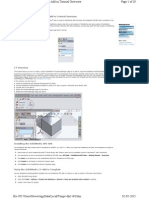Tutorial 3 (Answer)
Uploaded by
miChiKoLeeTutorial 3 (Answer)
Uploaded by
miChiKoLeeAACS4134 Internet Programming
Chapter 3
Tutorial 3 (Solution)
1. An event is an action taken on your application by some force outside of your code. This external force is usually the user, but could be another program. An event can hold that will run when the action occurs. An event handler is a method thats called when a specified event occurs. An event handler must be declared with Public or Protected scope. A function or method containing program statements that are executed in response to an event. An event handler typically is a software routine that processes actions such as keystrokes and mouse movements. With Web sites, event handlers make Web content dynamic. JavaScript is a common method of scripting event handlers for Web content. (www.webopedia.com) Its a good way of programming because much more work is automatically performed for us. Great range of events available to improve the user experience reduces the amount of code, and codes are easier to maintain. 2. HTML Event onmouseup onmousedown onmouseover onmousemove onclick ondbclick onkeyup onkeypress onkeydown 3. ASP.NET Server Control Event ondatabinding ondispose onload onunload oninit onprerender
Chapter 3: Event-Driven Programming and Postback
AACS4134 Internet Programming
Chapter 3
4(a). Answer depends on students justifications. She/he needs to compare which one is better. Server-side event handler: Upside can execute the event handler code on the server, which means that you have all the server resource available for the event handler. This includes custom-built objects and connection to other servers and databases dont have to rely on the browsers capability to recognize and handle HTML events because the ASP.NET Web server sends only pure HTML back to the browser. can write code for an event handler in any language that is supported by .NET instead of just the scripting language that browsers can execute. Downside Information is post back and handled by server, and therefore server reacts to the event slower, i.e. could not react to the users action as quickly as expected. (high CPU and bandwidth costs are high) Client-side event handler: Upside: An interpreter built into the browser executes the code and there is no transfer of information to or action on the part of the server. (Performance is faster) Downside: Harder to code (use JavaScript, VBScript, or Java applets) (example: data manipulation is harder) Harder to support multiple/older browsers (e.g. not all old browser supports JavaScript) 4(b). Some events need quick response to the user, such as pop-up dialog box, or form validation that typically run on client-side JavaScript/VBScript. So we still need a mix of server-side and client-side event functions in the Web application. 5. HTTP is stateless, meaning that it retains no knowledge from one request to the next. So, when user request a page from a web server, the page is sent to user and the server immediately forgets everything about you; each request stand alone. When postback is used, information about the state of the ASP.NET form is sent back in an associated hidden control _VIEWSTATE. Information (value) in _VIEWSTATE is generated by ASP.NET by encrypting the values of the old state of the form (e.g. user selections for each Web control).With this information, ASP.NET can persist the state between page submissions.
6.
Chapter 3: Event-Driven Programming and Postback
AACS4134 Internet Programming
Chapter 3
7.
Source code in the Page_Load event handler executes every time the ASP.NET web page is requested. When the user visits the page for the first time, she has yet to enter the loan amount, interest rate and total number of month. Therefore, in attempting to compute the calculation, we will get an error. Specifically, the code will try to perform numerical calculations on a user-inputted value that has yet to be provided. Because we want to perform the calculation only after user has provided the required inputs, the source code for the calculation is placed in the Button_Click event handler.
Chapter 3: Event-Driven Programming and Postback
You might also like
- Javascript For Beginners: Your Guide For Learning Javascript Programming in 24 HoursFrom EverandJavascript For Beginners: Your Guide For Learning Javascript Programming in 24 Hours3/5 (13)
- Static Web Page Dynamic Web Page Content: - Differences Between Client-Side & Server-Side Dynamic PagesNo ratings yetStatic Web Page Dynamic Web Page Content: - Differences Between Client-Side & Server-Side Dynamic Pages20 pages
- Sirwan Mohammad Amin-Databse-ApplicationNo ratings yetSirwan Mohammad Amin-Databse-Application16 pages
- ASP.NET For Beginners: The Simple Guide to Learning ASP.NET Web Programming Fast!From EverandASP.NET For Beginners: The Simple Guide to Learning ASP.NET Web Programming Fast!No ratings yet
- Microsoft AJAX Library Essentials: Client-side ASP.NET AJAX 1.0 ExplainedFrom EverandMicrosoft AJAX Library Essentials: Client-side ASP.NET AJAX 1.0 ExplainedNo ratings yet
- JavaScript Programming: 3 In 1 Security Design, Expressions And Web DevelopmentFrom EverandJavaScript Programming: 3 In 1 Security Design, Expressions And Web DevelopmentNo ratings yet
- Ans:There Are Several Ways To Do So. If You Are Using A Dataset, You CanNo ratings yetAns:There Are Several Ways To Do So. If You Are Using A Dataset, You Can21 pages
- Server Controls and Events: IT 4203 Advanced Web DevelopmentNo ratings yetServer Controls and Events: IT 4203 Advanced Web Development25 pages
- Advance .Net Technology - ASP .Net - 13102015 - 1043000AM - 13102015 - 053841AMNo ratings yetAdvance .Net Technology - ASP .Net - 13102015 - 1043000AM - 13102015 - 053841AM32 pages
- Introduction To: Sandeep Sharma 381/09 Ee-5 SemNo ratings yetIntroduction To: Sandeep Sharma 381/09 Ee-5 Sem24 pages
- Ian Talks JavaScript Libraries and Frameworks A-Z: WebDevAtoZ, #4From EverandIan Talks JavaScript Libraries and Frameworks A-Z: WebDevAtoZ, #4No ratings yet
- AJAX Interview Questions, Answers, and Explanations: AJAX Certification ReviewFrom EverandAJAX Interview Questions, Answers, and Explanations: AJAX Certification ReviewNo ratings yet
- JavaScript QuickStart Guide: The Simplified Beginner's Guide to Building Interactive Websites and Creating Dynamic Functionality Using Hands-On ProjectsFrom EverandJavaScript QuickStart Guide: The Simplified Beginner's Guide to Building Interactive Websites and Creating Dynamic Functionality Using Hands-On ProjectsNo ratings yet
- Concepts and Examples: Aniket Sarkar Sanjib SarkarNo ratings yetConcepts and Examples: Aniket Sarkar Sanjib Sarkar26 pages
- Aprende programación python aplicaciones web: python, #2From EverandAprende programación python aplicaciones web: python, #2No ratings yet
- Chapter 1: An Introduction To: Liu, JieNo ratings yetChapter 1: An Introduction To: Liu, Jie10 pages
- The Software Programmer: Basis of common protocols and proceduresFrom EverandThe Software Programmer: Basis of common protocols and proceduresNo ratings yet
- Four Programming Languages Creating a Complete Website Scraper ApplicationFrom EverandFour Programming Languages Creating a Complete Website Scraper ApplicationNo ratings yet
- And Web Forms: Arijit Sengupta S511 Module 5No ratings yetAnd Web Forms: Arijit Sengupta S511 Module 584 pages
- ETHICAL HACKING GUIDE-Part 3: Comprehensive Guide to Ethical Hacking worldFrom EverandETHICAL HACKING GUIDE-Part 3: Comprehensive Guide to Ethical Hacking worldNo ratings yet
- Master of Computer Application (MCA) - Semester 5 MC0081 - (DOT) Net Technologies - 4 CreditsNo ratings yetMaster of Computer Application (MCA) - Semester 5 MC0081 - (DOT) Net Technologies - 4 Credits17 pages
- jQuery For Beginners: jQuery JavaScript Library Guide For Developing Ajax Applications, Selecting DOM Elements, Creating AnimationsFrom EverandjQuery For Beginners: jQuery JavaScript Library Guide For Developing Ajax Applications, Selecting DOM Elements, Creating AnimationsNo ratings yet
- The Following Slides Are For Your Reference Only. Feel Free To Do More ExplorationNo ratings yetThe Following Slides Are For Your Reference Only. Feel Free To Do More Exploration23 pages
- Tutorial 6 (Solution) : AACS4134 Internet ProgrammingNo ratings yetTutorial 6 (Solution) : AACS4134 Internet Programming4 pages
- 150611-150704-Object Oriented Programming With JavaNo ratings yet150611-150704-Object Oriented Programming With Java2 pages
- 3ds Max To VRML - Exporter Tutorials: (Cut and Pasted From:)No ratings yet3ds Max To VRML - Exporter Tutorials: (Cut and Pasted From:)28 pages
- The SAP Fiori Reference App Manage ProductsNo ratings yetThe SAP Fiori Reference App Manage Products19 pages
- Mt11060 - Nx-6-2007 - Post Building Techniques PDF100% (1)Mt11060 - Nx-6-2007 - Post Building Techniques PDF250 pages
- How Do I View Events Fired On An Element in Chrome Web DeveloperNo ratings yetHow Do I View Events Fired On An Element in Chrome Web Developer2 pages
- Java Programming: From Problem Analysis To Program Design, 5eNo ratings yetJava Programming: From Problem Analysis To Program Design, 5e34 pages
- Rabbitmq Dotnet Client 2.7.1 User GuideNo ratings yetRabbitmq Dotnet Client 2.7.1 User Guide52 pages
- Lab 04 - Exception Handling and Event Handling (Answers) PDFNo ratings yetLab 04 - Exception Handling and Event Handling (Answers) PDF5 pages

































































































